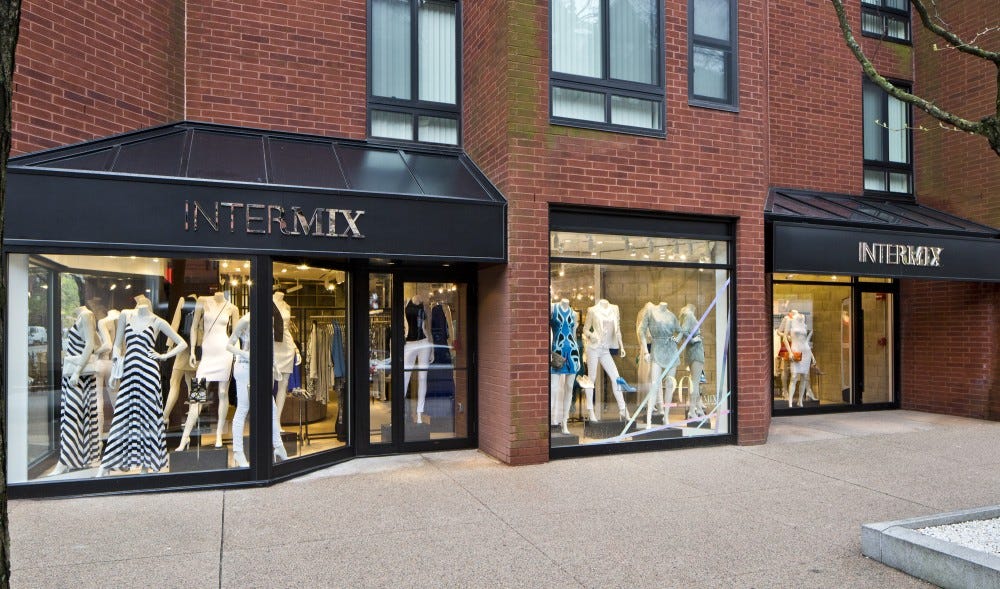Retail Confessions: Intermix
"One of the managers joked she had seen some meme on the internet like, 'Intermix is just Zara for rich people.'"
If one store seemed destined to perish in the retail apocalypse, it was Intermix. Filled with upscale occasion-wear and Jordan almond-colored leather jackets, the use cases for its clothes seemed dangerously — confusingly — limited. How long could bandage dresses, $200 jeans, and Iro sustain an entire 31-store chain?
Turns out, around 30 years, maybe longer if Gap hadn’t started messing with it.
The boutique was founded by brothers Khajak and Haro Keledjian in 1993, and sold to the Gap in 2012 for $130 million. In 2021, private equity firm Altamont Capital Partners bought it for an undisclosed amount. In 2022, it was acquired by another private equity firm, Regent. Having been subjected to the PE meat mallet, the stores are gone, as though they were always a mirage, and Intermix remains little more than a website pushing Golden Goose and Ulla Johnson.
Ahead, someone who worked at the Boston store in its heyday in the 2010s talks about how changes implemented by Gap started alienating the “club girls” who liked to shop there. “All of a sudden, we started just getting all these silk rompers and all of these silk tops from the Intermix brand, and a lot of our core customers — they didn't want those things,” this former employee said.
The Boston store was located on Newbury Street, by an Aldo and the restaurant Stephanie’s, where people would flock for brunch even though the food was bad. As a result, the customer mix included people who would spill in from there, drunk, and parents of local college students.
If you are a former luxury retail worker who wants to confess for a future column, reply to this email or write me at amyodellbooks (at) gmail (dot) com.
I never understood Intermix. I’m surprised its still around. Why did people shop there?
The story they told new employees was we have all the brands of Saks and Barneys, but instead of having to go through all these floors and departments, we have just the best of the best. At the Boston store, we sold Alaïa. We were only one of a few stores in the company that sold Alaïa. We had Rick Owens, but only a couple of stores sold it. We had Narciso Rodriguez, Pucci, YSL shoes and accessories, all the Proenza Schouler bags, Stella McCartney ready-to-wear and handbags. Then all the contemporary names. Veronica Beard was starting to get really big toward the end of my time there.
The way they merchandised it at the time was very trendy. One of the managers joked she had seen some meme on the internet like, “Intermix is just Zara for rich people.”
How would you describe the Intermix customer?
Madison Avenue was, like, the flagship store. A girl who worked there on her own sold $4 to $5 million a year. The Boston store was not in that top tier, but I think we did maybe around $5 million a year in sales when I was there, so it was pretty busy. International students were a really, really a big group of customers. The Middle East, Asia, some Latin America — people from very wealthy families from these countries who would come to study in Boston.
Parents’ weekend coincided with the weather starting to change. So you have these wealthy students with their parents in town who had the credit cards. Everyone was out on Newbury Street, back-to-school shopping. For a lot of people it's very normal to be like, “Let me take my daughter back-to-school shopping and drop $6,000 at Intermix.” Maybe that was the mom who would buy The Row for herself, but she was like, Eh, that's a little expensive for my daughter, but a $1,200 Canada Goose jacket — that's reasonable.
Who were your best clients?
Keep reading with a 7-day free trial
Subscribe to Back Row to keep reading this post and get 7 days of free access to the full post archives.




